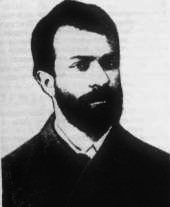Vladimir Bogoraz
| Vladimir Bogoraz | |
|---|---|

Vladimir Bogoraz
|
|
| Born | 27 (O.S. 15) April 1865 Ovruch, Russian Empire |
| Died | 10 May 1936 (aged 71) aboard a train near Kharkiv, Ukraine, USSR |
| Nationality | Russian |
| Fields | anthropology |
| Known for | ethnography and ethnology of the Chukchi people |
Vladimir Germanovich Bogoraz (Russian: Влади́мир Ге́рманович Богора́з), who was born Natan Mendelevich Bogoraz (Russian: Ната́н Ме́нделевич Богора́з) and used the literary pseudonym N. A. Tan (Russian: Н. А. Тан) (April 27 [O.S. April 15] 1865 — May 10, 1936), was a Russian revolutionary, writer and anthropologist, especially known for his studies of the Chukchi people in Siberia.
Bogoraz was born in the city of Ovruch in the family of a Jewish school teacher. After finishing Chekhov Gymnasium in 1882, he enrolled in the Faculty of Law of Saint Petersburg University, but was dismissed for revolutionary activity with Narodnaya Volya and exiled to his parents' home in Taganrog. He spent 11 months at Taganrog prison for revolutionary propaganda. In 1886, he moved to Saint Petersburg, where he was arrested and later exiled into northeastern Siberia, near Yakutsk (1889–1899), where he studied the Chukchi people, their way of life, traditions, language, and beliefs, giving him valuable material for poems and essays.
Bogoraz published his first literary works in the early 1880s, but he became famous by 1896–1897 under the literary pseudonym Tan for poems and novels published in various periodicals. In 1899, he published the book Chukchi Tales and in 1900, Poems. The ethnographical materials he published in periodicals of the Russian Academy of Sciences, such as "Specimens of Materials for Studying Chukchi Language and Folklore" and "Studies of Chukchi Language and Folklore Collected in Kolyma District," were a valuable contribution to the development of linguistics and made the author known around the world. In 1899, by recommendation of the Academy of Sciences, Bogoraz was invited by New York City's American Museum of Natural History for the Jesup North Pacific Expedition (1900–1901) aimed at studying the ethnography, anthropology and archaeology of the Northern coasts of the Pacific Ocean, where Tan-Bogoraz and his friend Vladimir Jochelson were in charge of the Anadyr region of Siberia, gathering materials for ethnographic studies of Chukchi, Koryaks, Lamuts and other indigenous Siberian peoples. He left Russia for political reasons in 1901 and settled in New York City, where he became curator of the American Museum of Natural History and produced his great works The Chukchee (1904–09) and Chukchee Mythology (1910).
...
Wikipedia
